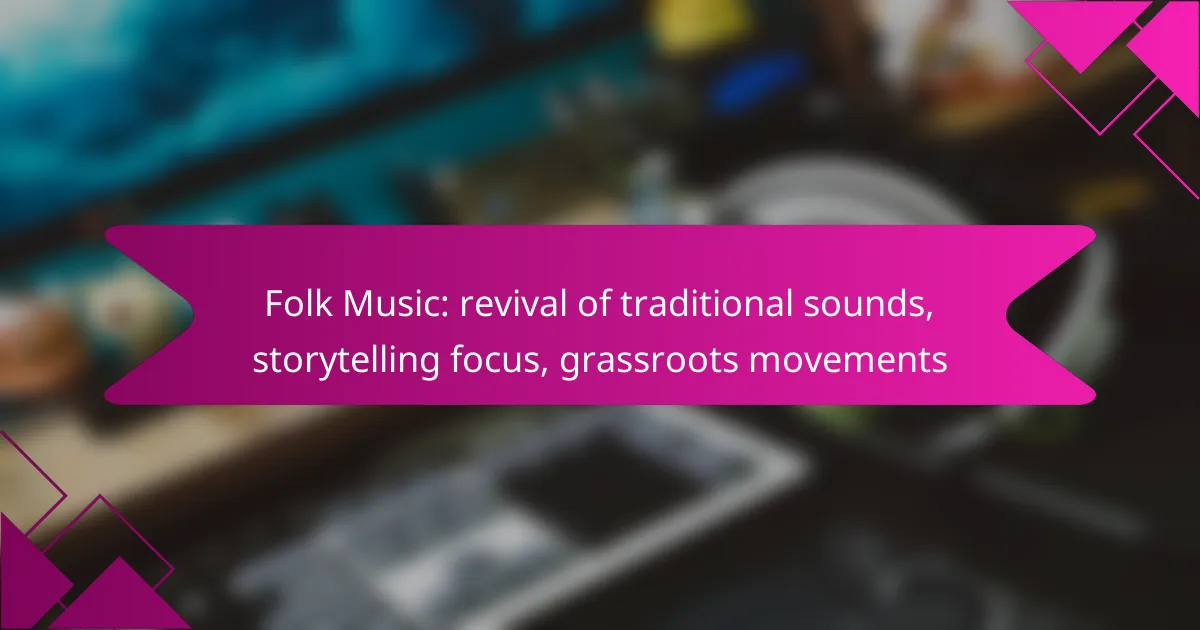The revival of folk music in the United States highlights a renewed appreciation for traditional sounds and storytelling, driven by grassroots movements and local artists. This modern iteration of folk emphasizes cultural heritage while addressing contemporary social and political issues, making it both relevant and accessible. Through community engagement and the use of digital platforms, these movements foster a deeper connection between artists and audiences, celebrating the rich tapestry of shared narratives.

How is folk music being revived in the United States?
Folk music in the United States is experiencing a revival through various grassroots movements that emphasize traditional sounds and storytelling. This resurgence is driven by local artists, community engagement, and the accessibility of digital platforms.
Grassroots festivals promoting local artists
Grassroots festivals play a crucial role in the revival of folk music by providing a platform for local artists to showcase their talents. These events often feature a mix of established and emerging musicians, allowing attendees to discover new sounds while celebrating regional traditions.
Many festivals are organized by community groups and are often free or low-cost, making them accessible to a wide audience. Examples include the Newport Folk Festival and the Kerrville Folk Festival, which highlight the importance of local culture and storytelling.
Community workshops for traditional instruments
Community workshops focused on traditional instruments are essential for preserving folk music’s heritage. These workshops often teach participants how to play instruments like the banjo, fiddle, or mandolin, fostering a deeper connection to the music.
Local organizations frequently host these workshops, which can range from casual jam sessions to structured classes. Participants not only learn to play but also engage with the history and stories behind the music, enriching their understanding of folk traditions.
Online platforms for sharing folk music
Online platforms have become vital for sharing and promoting folk music, allowing artists to reach wider audiences without the constraints of traditional media. Websites like Bandcamp and SoundCloud enable musicians to upload their work, connect with fans, and sell their music directly.
Social media also plays a significant role in the folk music revival, with artists using platforms like Instagram and TikTok to share performances and engage with followers. This accessibility encourages collaboration and innovation within the folk music community, helping to keep the genre vibrant and relevant.
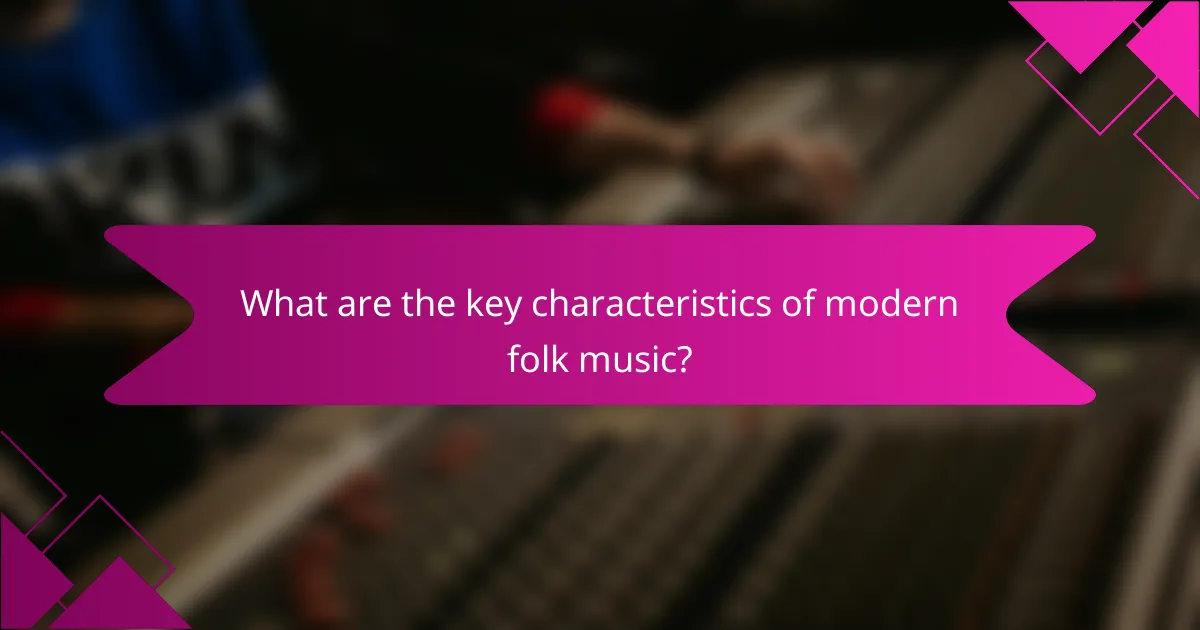
What are the key characteristics of modern folk music?
Modern folk music is characterized by its emphasis on storytelling, the use of traditional instruments, and a focus on social and political issues. It often draws from cultural heritage while incorporating contemporary themes, making it accessible and relevant to today’s audiences.
Storytelling as a central theme
Storytelling is a fundamental aspect of modern folk music, with songs often narrating personal experiences, historical events, or social commentary. This narrative style engages listeners and fosters a deeper connection to the music.
Artists frequently use vivid imagery and relatable characters to convey their messages, allowing audiences to reflect on their own lives and experiences. For example, a song might recount the struggles of a particular community, encouraging empathy and understanding.
Use of traditional instruments
Modern folk music typically features traditional instruments such as acoustic guitars, banjos, fiddles, and mandolins. These instruments contribute to the genre’s authentic sound and help preserve cultural heritage.
Musicians may blend these traditional sounds with modern techniques or electronic elements, creating a unique fusion that appeals to a wide range of listeners. This combination allows for innovation while respecting the roots of folk music.
Focus on social and political issues
Many modern folk songs address pressing social and political issues, reflecting the concerns of contemporary society. Artists often use their platforms to raise awareness about topics like inequality, environmental challenges, and human rights.
This focus on activism resonates with audiences who seek music that not only entertains but also inspires change. By weaving these themes into their lyrics, folk musicians encourage listeners to engage with the world around them and consider their own roles in driving progress.
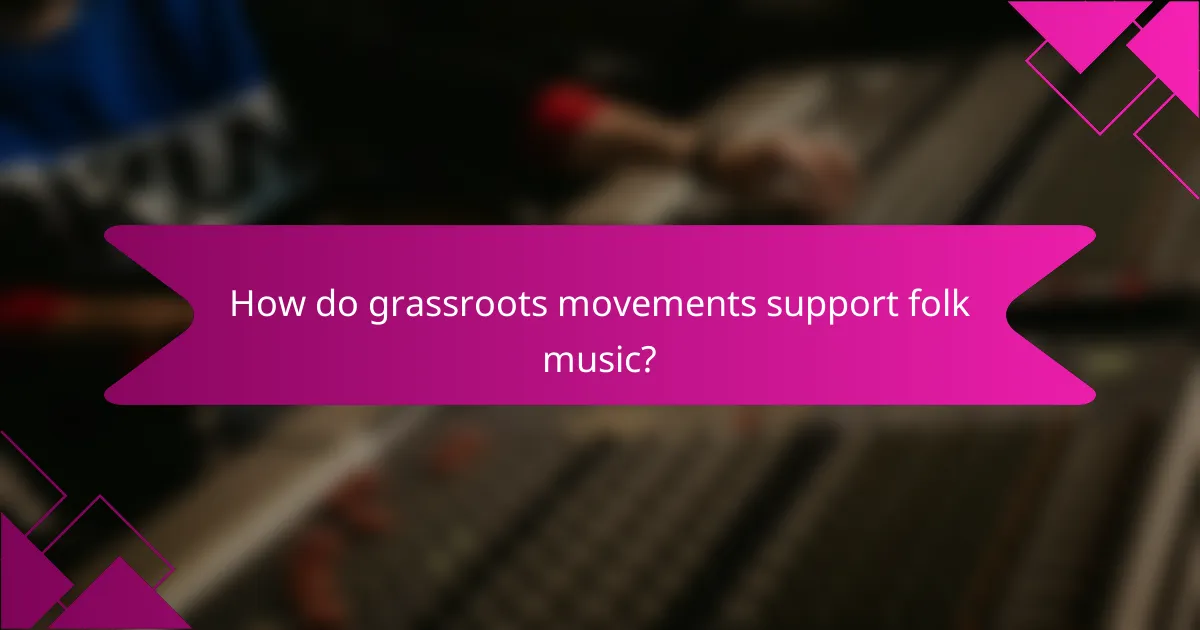
How do grassroots movements support folk music?
Grassroots movements play a crucial role in supporting folk music by creating community-driven initiatives that promote traditional sounds and storytelling. These movements often emphasize local participation, encouraging artists and audiences to engage with their cultural heritage in meaningful ways.
Local music collectives fostering collaboration
Local music collectives serve as hubs for collaboration among folk musicians, providing spaces for artists to share ideas, resources, and performances. These collectives often organize jam sessions, workshops, and open mic nights, allowing musicians to connect and learn from one another.
By fostering a sense of community, these collectives help preserve traditional styles while encouraging innovation. For example, a collective might host a monthly gathering where musicians can experiment with blending genres, creating new interpretations of folk music.
Non-profit organizations preserving cultural heritage
Non-profit organizations dedicated to preserving cultural heritage play a vital role in the folk music revival. They often focus on documenting traditional music, providing educational resources, and supporting artists through grants and funding opportunities.
These organizations may run programs that teach traditional instruments or storytelling techniques, ensuring that skills are passed down through generations. Additionally, they often collaborate with local schools and community centers to reach a wider audience, making folk music accessible to all.
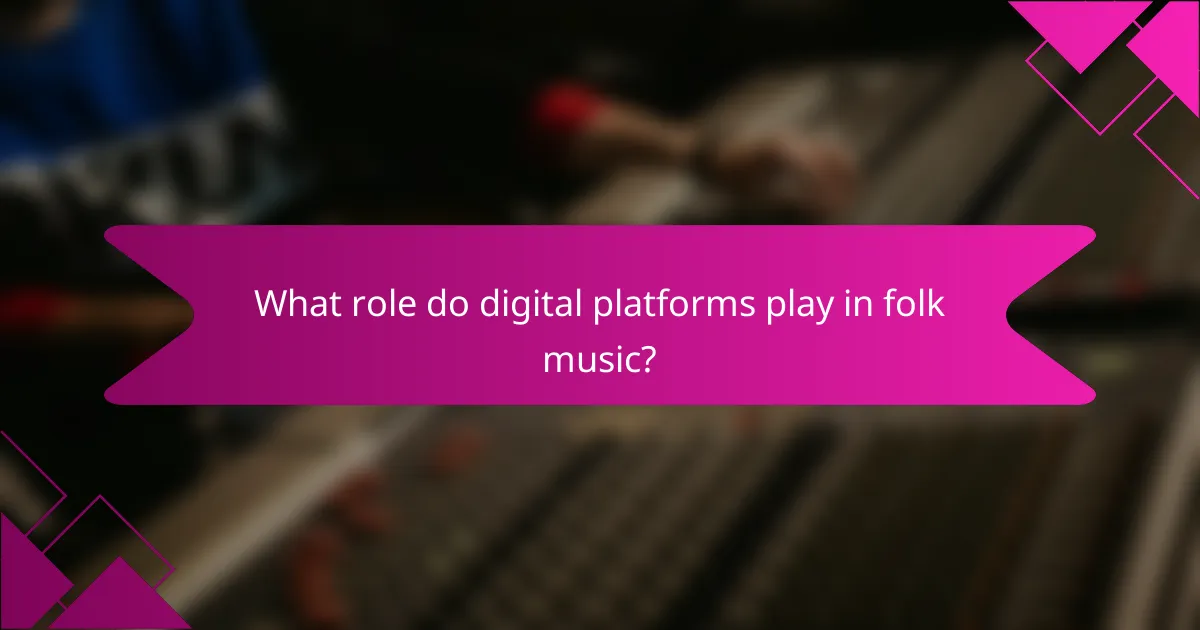
What role do digital platforms play in folk music?
Digital platforms significantly enhance the reach and accessibility of folk music, allowing independent artists to share their traditional sounds and storytelling with a global audience. These platforms facilitate connections between musicians and listeners, fostering grassroots movements and revitalizing interest in folk traditions.
Streaming services for independent artists
Streaming services like Spotify, Apple Music, and Bandcamp provide independent folk artists with the opportunity to distribute their music widely without the need for a traditional record label. Artists can upload their tracks, set their pricing, and even offer exclusive content to fans, which can lead to increased revenue and exposure.
Many platforms allow artists to track listener statistics, helping them understand their audience better. This data can guide marketing strategies and inform decisions about live performances or merchandise offerings.
Social media for audience engagement
Social media platforms such as Instagram, Facebook, and TikTok are crucial for folk musicians to engage with their audience directly. Artists can share behind-the-scenes content, live performances, and personal stories that resonate with fans, creating a deeper connection.
Using social media effectively can lead to viral moments that significantly boost an artist’s visibility. Regular interaction with followers can also foster a loyal community, encouraging fans to support their work through shares, comments, and attendance at live shows.
Online courses for learning folk music
Online courses and tutorials on platforms like YouTube, Udemy, and Skillshare offer aspiring folk musicians the chance to learn traditional instruments and techniques from experienced artists. These resources can range from free videos to paid courses, catering to various skill levels and budgets.
Participating in online workshops or webinars can provide valuable feedback and foster a sense of community among learners. Many courses also include interactive elements, such as Q&A sessions, which enhance the learning experience and help students apply what they have learned in practical settings.

How can you participate in the folk music revival?
You can participate in the folk music revival by engaging with local events, joining online communities, and supporting independent artists. These actions help preserve traditional sounds and promote storytelling through grassroots movements.
Attend local folk music events
Attending local folk music events is a direct way to experience and support the revival of traditional sounds. Look for concerts, festivals, and open mic nights in your area, which often feature local talent and foster community connections.
Check local listings or community boards for upcoming events. Many cities have folk music societies or cultural organizations that regularly host gatherings, making it easy to find opportunities to participate.
Join online folk music communities
Joining online folk music communities allows you to connect with like-minded individuals and discover new artists. Platforms like Facebook, Reddit, and dedicated forums offer spaces to discuss folk music, share recommendations, and collaborate on projects.
Engaging in these communities can enhance your understanding of folk traditions and introduce you to grassroots movements. Look for groups that focus on specific genres or regional styles to deepen your appreciation and involvement.
Support independent folk artists on crowdfunding platforms
Supporting independent folk artists through crowdfunding platforms is a practical way to contribute to the revival. Websites like Kickstarter and Patreon allow you to financially back projects, helping artists produce albums, organize tours, or create music videos.
Consider setting a budget for supporting artists you admire, whether it’s a small monthly contribution or a one-time donation. This not only helps sustain their work but also fosters a vibrant folk music scene that thrives on community support.
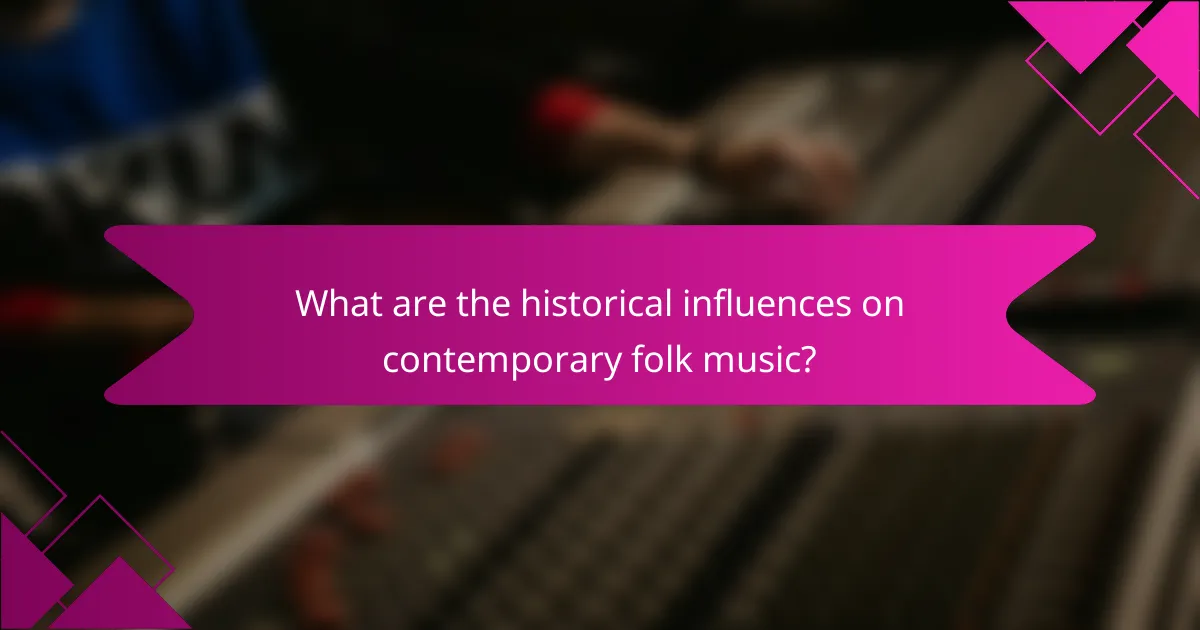
What are the historical influences on contemporary folk music?
Contemporary folk music is deeply rooted in historical influences, primarily traditional folk songs and the cultural movements that revived them. These influences shape the storytelling focus and grassroots nature of the genre, reflecting the experiences and emotions of everyday people.
Roots in traditional American folk songs
Traditional American folk songs serve as the foundation of contemporary folk music, drawing from diverse cultural backgrounds including African, Native American, and European influences. These songs often convey stories of hardship, love, and social issues, making them relatable and timeless.
Examples of traditional folk songs include “This Land Is Your Land” and “Oh Susanna,” which highlight themes of community and resilience. The simplicity of their melodies and lyrics allows for easy adaptation, encouraging new generations to interpret and perform them.
Impact of the 1960s folk revival
The 1960s folk revival marked a significant resurgence of interest in folk music, driven by social movements and a desire for authenticity. Artists like Bob Dylan and Joan Baez brought folk music to the forefront, using it as a platform for political and social commentary.
This era emphasized the importance of storytelling in music, with lyrics addressing civil rights, war, and environmental issues. The revival not only popularized traditional sounds but also inspired grassroots movements, encouraging communities to engage with their musical heritage and create new works that resonate with contemporary audiences.
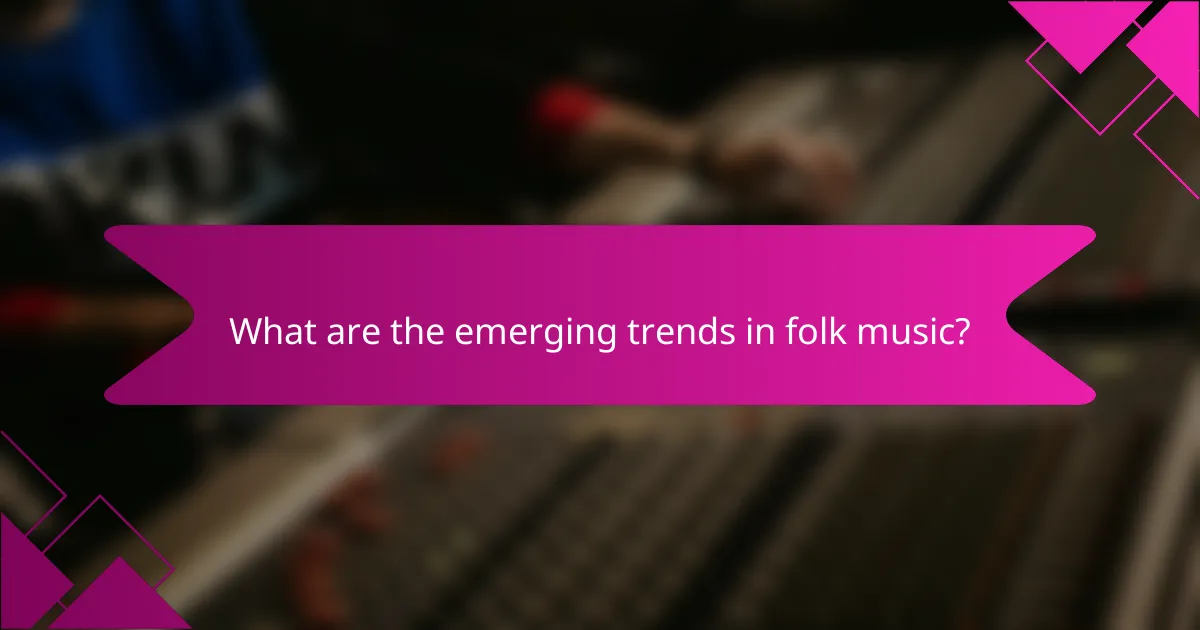
What are the emerging trends in folk music?
Emerging trends in folk music include a revival of traditional sounds, a focus on storytelling, and the influence of grassroots movements. These trends reflect a growing interest in authenticity and cultural heritage, often blending with contemporary styles to reach wider audiences.
Fusion with other genres like indie and pop
Folk music is increasingly merging with genres such as indie and pop, creating a fresh sound that appeals to diverse listeners. This fusion often incorporates modern instrumentation and production techniques while maintaining the narrative essence of traditional folk.
Artists like Mumford & Sons and The Lumineers exemplify this trend, using folk elements alongside pop melodies and indie rhythms. This blend not only broadens the audience but also revitalizes folk music, making it relevant in today’s music scene.
When exploring this fusion, consider the balance between traditional and contemporary elements. Strive for authenticity in lyrics and storytelling while experimenting with new sounds and arrangements to engage listeners effectively.
